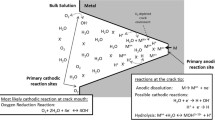Abstract
A combined mechanical/electrochemical model has been developed which successfully predicts the corrosion fatigue initiation behavior of an iron-base superalloy using readily measurable electrochemical and mechanical properties. In particular, the model uses the current decay curve, the initial or bare metal corrosion rate, and the critical slip step height, a parameter associated with the transition from an intense slip band to an incipient crack. The exponential parameter,α, used to fit the early (short time) portion of the current decay curve has been found to scale with the fatigue crack initiation time, suggesting thatα could be used as a valuable screening aid to assess the corrosion fatigue susceptibility of any alloy under passive electrochemical conditions. The model permits accurate prediction of both the shape and magnitude of fatigue life (S-N) curves. The limitations and theoretical implications of the approach of this model are also discussed.
Similar content being viewed by others

References
M. Mueller:Corrosion, 1982, vol. 38, pp. 431–36.
M. Mueller:Metall. Trans. A, 1982, vol. 13A, pp. 649–55.
T. Pyle, V. Rollins, and D. Howard:J. Electrochem. Soc., 1975, vol. 122, pp. 1445–53.
C. Patel, T. Pyle, and V. Rollins:Met. Sci., 1977, vol. 11, pp. 185–95.
C. Laird and J. Duquette: inCorrosion Fatigue (NACE-2), O. Devereux, A.J. McEvily, and R.W. Staehle, eds., NACE, Houston, TX, 1972, pp. 88–115.
J.C. Scully: inEnvironment-Sensitive Fracture of Engineering Materials, Z.A. Foroulis, ed., TMS-AIME, Warrendale, PA, 1979, pp. 71–90.
T. Nakayama and M. Takano:Corrosion, 1986, vol. 42, pp. 10–15.
J.W. Martin and D.E. Talbot:Nucl. Technol., 1981, vol. 55, pp. 499–504.
K. Tanaka, Y. Nakai, and M. Yamashita:Int. J. Fract., 1981, vol. 17, pp. 519–33.
K. Tanaka and Y. Nakai: inFatigue Crack Growth Threshold Concepts, D.L. Davidson and S. Suresh, eds., TMS-AIME, Warrendale, PA, 1984, pp. 497–516.
R. Summitt: Final Report No. N00014-K-0419, Michigan State University, East Lansing, MI, March 1986.
T.W. Crooker and J.A. Hauser II: NRL Memorandum Report 5763, Naval Research Laboratory, Washington, DC, April 1986.
A. Turnbull and J.G.N. Thomas:J. Electrochem. Soc., 1982, vol. 129, pp. 1412–22.
M.A. Daeubler, A.W. Thompson, and I.M. Bernstein:Metall. Trans. A, 1991, vol. 22A, pp. 513–19.
B.F. Brown: inStress Corrosion Cracking and Hydrogen Embrittlement of Iron Base Alloys, J. Hochmann, J. Slater, R.D. McCright, and R.W. Staehle, eds., NACE, Houston, 1976, pp. 747–50.
Corrosion Fatigue-Mechanics, Metallurgy, Electrochemistry and Engineering, STP 801, T.W. Crooker and B.N. Leis, eds., ASTM, Philadelphia, PA, 1983.
Embrittlement by the Localized Crack Environment, R.P. Gangloff, ed., TMS-AIME, Warrendale, PA, 1984.
Modeling Environmental Effects on Crack Growth Processes, R.H. Jones and W.W. Gerberich, eds., TMS-AIME, Warrendale, PA, 1986.
Small Fatigue Cracks, R.O. Ritchie and J. Lankford, eds., TMS-AIME, Warrendale, PA, 1986.
R.P. Wei and G.W. Simmons:Int. J. Fract., 1981, vol. 17, pp. 235–47.
K. Landes, J. Congleton, and R.N. Parkins: inEmbrittlement by the Localized Crack Environment, R.P. Gangloff, ed., TMS-AIME, Warrendale, PA, 1984, pp. 59–74.
R.P. Gangloff:Metall. Trans. A, 1985, vol. 16A, pp. 953–69.
A. Turnbull and D.H. Ferriss: inModeling Environmental Effects on Crack Growth Processes, R.H. Jones and W.W. Gerberich, eds., TMS-AIME, Warrendale, PA, 1986, pp. 3–39.
R.H. Jones, M.J. Danielson, and C.A. Oster: inModeling Environmental Effects on Crack Growth Processes, R.H. Jones and W.W. Gerberich, eds., TMS-AIME, Warrendale, PA, 1986, pp. 41–54.
B.N. Leis: inModeling Environmental Effects on Crack Growth Processes, R.H. Jones and W.W. Gerberich, eds., TMS-AIME, Warrendale, PA, 1986, pp. 301–19.
R.A. Cottis: inSmall Fatigue Cracks, R.O. Ritchie and J. Lankford, eds., TMS-AIME, Warrendale, PA, 1986, pp. 265–68.
A. Turnbull and R.C. Newman: inSmall Fatigue Cracks, R.O. Ritchie and J. Lankford, eds., TMS-AIME, Warrendale, PA, 1986, pp. 269–88.
F.P. Ford and S.J. Hudak: inSmall Fatigue Cracks, R.O. Ritchie and J. Lankford, eds., TMS-AIME, Warrendale, PA, 1986, pp. 289–308.
M. Barbosa:Corrosion, 1987, vol. 43, pp. 309–18.
M.A. Daeubler, A.W. Thompson, and I.M. Bernstein:Metall. Trans. A, 1988, vol. 19A, pp. 301–08.
M. Kendig and F. Mansfield:Application of Electrochemical and Mechanical Impedance Techniques for Evaluation of Stress Corrosion Cracking and Corrosion Fatigue, Proc. Corrosion Research Symp., NACE, Houston, TX, 1986, in press.
H.H. Johnson and P.C. Paris:Eng. Fract. Mech., 1970, vol. 1, pp. 3–45.
R.P. Wei:Eng. Fract. Mech., 1970, vol. 1, pp. 633–51.
R.W. Staehle: inThe Theory of Stress Corrosion Cracking of Alloys, J.C. Scully, ed., NATO, Brussels, Belgium, 1971, pp. 223–86.
A. Boateng, J.A. Begley, and R.W. Staehle:Corrosion, 1980, vol. 36, pp. 633–38.
D. J. Duquette: inEnvironment-Sensitive Fracture of Engineering Materials, Z.A. Foroulis, ed., TMS-AIME, Warrendale, PA, 1979, pp. 521–37.
G.T. Burstein and P.I. Marshall:Corros. Sci., 1984, vol. 24, pp. 449–62.
A. Turnbull and D.H. Ferriss:Corros. Sci., 1986, vol. 26, pp. 601–28.
G.T. Gray, A.W. Thompson, and J.C. Williams:Metall. Trans. A, 1985, vol. 16A, pp. 753–60.
M.A. Daeubler, A.W. Thompson, and I.M. Bernstein:Metall. Trans. A, 1990, vol. 21A, pp. 925–33.
Author information
Authors and Affiliations
Additional information
Formerly Postdoctoral Associate, Carnegie Mellon University
Formerly Associate Professor, Carnegie Mellon University
Formerly Professor, Carnegie Mellon University
Rights and permissions
About this article
Cite this article
Daeubler, M.A., Warren, G.W., Bernstein, I.M. et al. Modeling of corrosion fatigue crack initiation under passive electrochemical conditions. Metall Trans A 22, 521–529 (1991). https://doi.org/10.1007/BF02656820
Received:
Issue Date:
DOI: https://doi.org/10.1007/BF02656820



